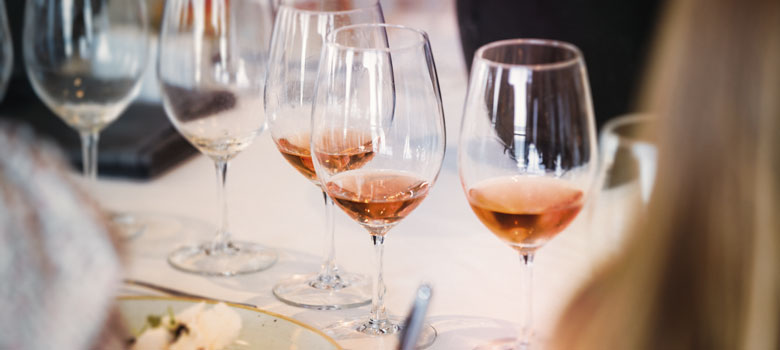
Wine
Sparkling and Champagne: Members' Tasting
When you want to splash out on bubbles for a special celebration, there’s a good chance Champagne will be your number one choice. And why wouldn’t it be? Champagne and luxury are synonymous and when you pop the cork on a bottle of one of the big name Houses, it’s assumed you’re pouring the pinnacle in quality.
You could also argue the exclusivity of Champagne has escalated since the 2010 agreement Australia made with the EU to stop using the moniker for wines made outside the historic French region.
But it’s not just a matter of growing grapes in Champagne to be able to name it as such. Winemakers have to adhere to strict yields and use the ‘méthode Champenoise.’ Labour intensive and expensive, this method sees the wine spend at least 15 months on lees following secondary fermentation, before the yeast cells are removed and the bottle is topped up with base wine, sugar is added, then the cork. This all occurs in the same bottle in which the final wine is sold.
The grapes that can go into Champagne are limited too, with Chardonnay, Pinot Noir and Pinot Meunier the only varieties allowed.
When it comes to sales of Champagne, Australians can’t get enough. More Champagne is drunk here than any other country outside of Europe.
aussie outlook
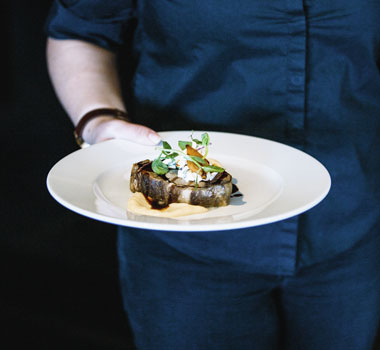
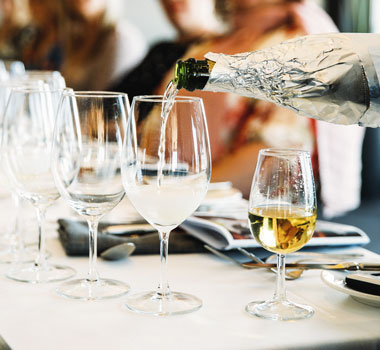
Pictured above (from left to right): 2-hour slow cooked pork neck, caramelised baby pear, cauliflower puree, black garlic and pork jus; Bubbles abound.
So where does that leave Australian Sparkling? While Wine Australia reports the numbers have been steady for a few years, Australians still drink about 3.5 million cases a year of homegrown fizz. What is changing is the amount people are willing to pay for it, with the $15-$50 bracket the fastest growing. This is a lot less than Champagne, where the majority of sales are in the $50-$100 a bottle range.
While Wine Selectors’ Tasting Panel members appreciate the magnificent wines of the top Champagne Houses, they are quick to add that being a famous Champagne name does not necessarily equate to quality.
As Wine Selectors’ head of buying Matthew White says, “Mass produced Champagne doesn’t have the complexity – I’d rather drink a great Australian Sparkling!”
What this is all leading up to is the inevitable comparison – which is better, Champagne or Australian Sparkling? But that’s a pointless contrast.
After all, as Tyson Stelzer wrote in our State of Play tasting on Australian Sparkling last year, “Australia is a world away from Champagne in every way, and while our makers borrow the method and fanatically follow quality cues of their northern French counterparts, no self-respecting Australian Sparkling maker is pretending to make Champagne.”
Matthew agrees, saying “Champagne and Australian Sparkling have their own unique attributes – it’s a matter of finding individual examples of each that appeal to your tastes.”
That’s exactly what the intention was behind our latest Members tasting. We brought together some of Wine Selectors’ keenest Sparkling wine drinkers to blind taste their way through a stunning line-up of Australian Sparkling and Champagne wines.
Time to sparkle
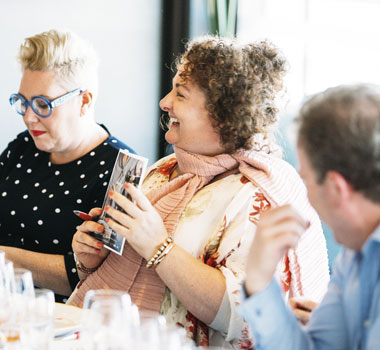
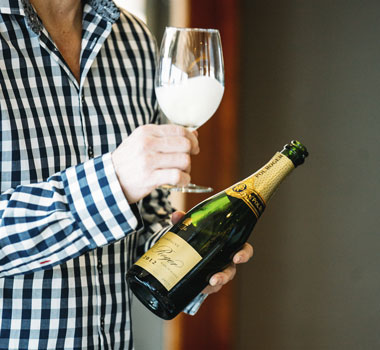
Pictured above (from left to right): Kristy Bridge gives her verdict; Recording favourites; Georgia Lazzari shares a laugh while Steph De Sousa takes notes; Paul Diamond swirling.
The sparkle of the wines was matched by that of the pristine ocean on panoramic view at Merewether Surfhouse in Newcastle. Ten Members sat down to a three-course lunch and what promised to be a lively discussion, hosted by Matthew and Selector publisher, Paul Diamond.
Before the tasting started, the guests were quizzed on their thoughts on the two styles. And the responses reiterated Wine Australia’s statistics.
As Georgia Lazzari said, “There’s an assumption that French will be better quality.” Her fellow Members concurred, with most saying they have a $50-$80 a bottle limit for Australian Sparkling.
Natasha Donnolley added, “It’s about reputation”, and Steph De Sousa agreed, saying, “(With a brand like Veuve) people know it has a good reputation, so you feel confident to take it somewhere.” Time would tell if those opinions held.
And the verdicts are
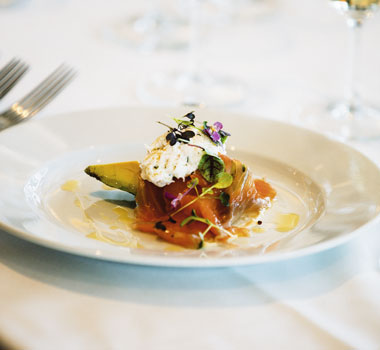
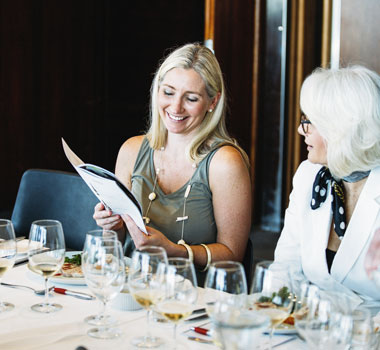
Pictured above (from left to right): Entree of crab with lemon and lime cured salmon, avocado, horseradish crème fraîche; Cath and Julie compare opinions.
First up were four 100 per cent Chardonnay wines, two Australian, two from Champagne. With the identity of the wines hidden, it was interesting to see where preferences landed.
The Champagnes were from Pol Roger and Ruinart, with the former praised for its easy-drinking appeal and the latter, while dividing opinions, was enjoyed for its bolder flavours. The Australians were from Jansz in Tasmania and Chandon in the Yarra Valley. At $75 and $35 a bottle respectively, it was the more modestly priced Chandon that earned the most ticks of the bracket. Emma Brunsdon, its most effusive fan, said, “It rests on the palate like a dream.”
Bracket two featured blends of the classic Champagne varieties and it’s safe to say, opinions were blended too. While some were taken with the fresh, fruity Bollinger, others enjoyed the earthiness of the Veuve. In the Australians, the Apogee was praised for its delicacy and the Arras for its great mouthfeel. Again, the fact the French wines were up to twice as expensive as the Australians didn’t translate to twice as nice.
Bracket three was more blends, this time starring Dom Perignon with its $275 price tag. Its beauty was appreciated across the board and its origins obvious to most, with Lisa Currie declaring, “Delicious, elegant, I’m guessing Champagne!”
Those who loved the Taittinger praised it for its attractive mouthfeel, with Kristy Bridge highlighting it as “delicate with apple and pear flavours.”
The Blue Pyrenees at just $36 a bottle was the wine of the tasting for Lisa. But it was the Arras Grand Vintage 08 that really turned heads. This was voted wine of the day overall, with Steph summing it up perfectly, “Every smell was something new and it kept getting more complex.”
It seems our Members are more in tune with the experts than they thought. This wine won Gold at the prestigious 2019 Six Nations Wine Challenge.
the appeal of pink
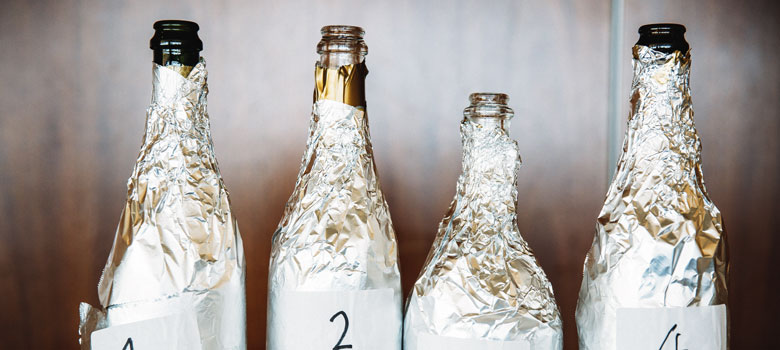
Pictured above: Disguised for impartial tasting.
The final bracket showcased six Sparkling and Champagne Rosés. It’s a style that represents only 10 per cent of the Sparkling market and at the moment, it’s more popular with industry insiders.
Some of the Members were initially dubious, including Racquel Goodchild, who assumed her ambivalence towards Rosé in general would transfer to the Sparkling style.
But by the end of the bracket, the Veuve Rosé was one of her top six wines of the day with her summation being, “Fun in a glass – perfume, perfume!”
Overall, preferences were pretty evenly spread across these wines, but the Clover Hill from Tasmania and the Charles Heidsieck were voted standouts. Steph praised the Heidsieck for its “smoky honey complexity”, while Kristy found the Clover Hill “crisp and refreshing.”
The lesson for Kristy was that you can impress with an Australian Rosé that’s a third of the price of its Champagne peer.
And this lesson was shared across the tasting. Price isn’t everything and while a certain Champagne might always be your choice for luxury, there’s plenty of appeal among Australian Sparkling.